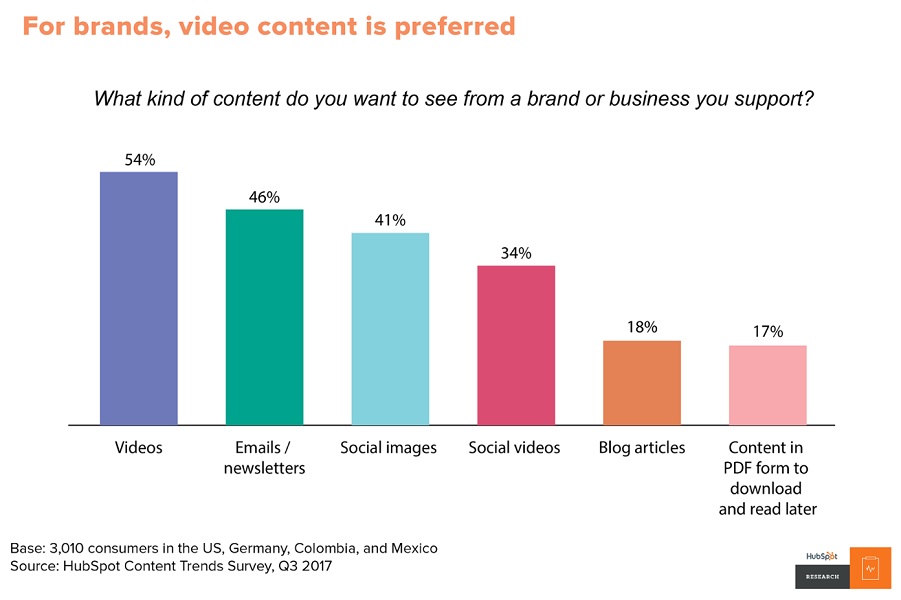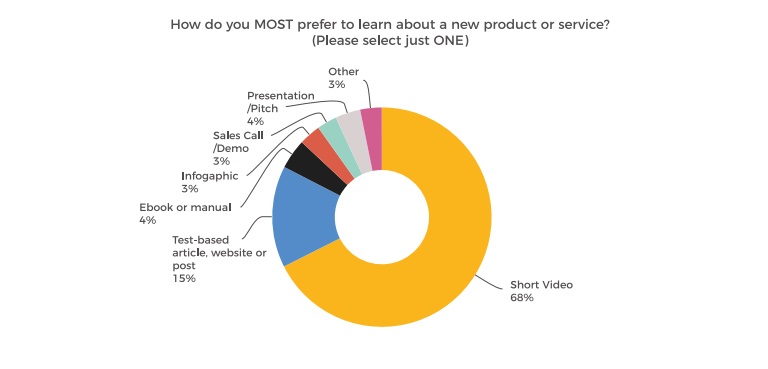The world of content seems to have shifted from classic blog articles into video marketing, evident in the rise of YouTube as the second largest search engine in the world (behind Google). In this article, we’ll go over video marketing tips and some tools to get started.
YouTube started in 2005 with only a few dozen uploads and has since grown into the largest video platform with over 30 million visitors and five billion videos watched every day. On top of that, the emergence of live streaming platforms like Instagram Story, Instagram TV, Facebook Live, Periscope, and Snapchat further prove the case.
A survey conducted by HubSpot in 2017 suggested that consumers prefer videos over any other form of content marketing. As a result of this, more and more brands are shifting their attention to video marketing. In 2019, the number of companies that use video as a marketing tool reached 87%, a significant increase from 63% in 2017, and 81% in 2018.

Source: HubSpot
What makes video marketing effective?
So, what triggers this change? For starters, we’re visual creatures. We naturally understand and connect faster while watching videos rather than reading posts. Our brains remember 95% of the information that we see in a video, while we only remember 10% of the information that we read.

Source: Wyzowl
The second reason is the popularity of smartphones. Over the last decade, people have become inseparable from this electronic device. The thing is, 75% of all video viewers on the internet are on mobile devices. More importantly, 92% of those mobile video watchers are willing to share the video with their friends. That means, if you create the right content for the right audience, your videos have a chance to go viral!
Video marketing tips to increase traffic
1. Create an engaging thumbnail
A video’s title and thumbnail are the first things the viewers see when browsing on Google, YouTube and other websites across the internet. It represents what your video is about and the content inside it. The more interested the viewers are in your title and thumbnail, the more likely they’ll click the video.
Tips:
- Make sure that the thumbnail is a shot from your own video, don’t try to fool the audience with fake images.
- Use interesting images from later on your video as a teaser to keep the audience watching.
- Having human interaction or close up faces as thumbnails will more likely affect the viewers’ emotions.
2. Create buzz on social media
When you’re doing a video marketing campaign, your focus should be on video sharing platforms like YouTube, as well as social media like Instagram, Twitter, Facebook, and Snapchat. On average, people spend almost two hours of their time on those platforms every single day. Sounds like a good goldmine to promote your brand, doesn’t it?
Tips:
- Post high-quality videos regularly and engage with your audience to build your brand presence.
- Optimize the use of tags on YouTube and hashtags on social media, so that your content becomes searchable.
- Reach out to influencers and other more popular brands to promote your content, in exchange for something in return.
3. Optimize it to be SEO friendly
Social media are platforms to build your brand awareness and presence. The end goal remains to bring the audience to your website, so you can convert them into loyal paying customers. Thus, it’s important that the videos on your website are search engine friendly.
Tips:
- Provide transcription to your video, so it will appear on general Google searches.
- Optimize your video file metadata with related and user intent keywords on the video’s title and description.
- Create a video sitemap and submit it to Google Search Console.
4. Make sure it’s mobile-friendly
As we mentioned before, most videos are watched on mobile devices. A survey conducted by Facebook found that people are 1.5x more likely to watch videos on a smartphone than on a computer.
Tips:
- Use responsive video players like YouTube, Vimeo, or Brightcove. Those platforms will automatically increase or reduce video quality according to the viewers’ bandwidth.
- Watch out for the text size, because a text that appears big on a TV screen will look small on a smartphone screen.
- Adjust the video playing time according to your purpose. An hour-long behind-the-scenes video is suited for YouTube, while a 60 seconds teaser is best for Instagram.
5. Create a clear call-to-action
Make sure to include a clear call-to-action in every video that you post. Without a clear CTA, viewers will be confused and not sure of what to do next. If you want more traffic to your site, it’s your duty to make it easier for the audience to find your site.
Tips:
- Use YouTube End Screens (the last 5-20 seconds of a video) to include up to four clickable elements, you can send people to your website, your other videos, channels, or particular landing page.
- When posting on social media, include a CTA and a link that leads to your website or landing pages.
Based on the audience’s demand for more video-based content and the emergence of YouTube as the second largest website in the world, video marketing seems to be the future of content marketing.
If you want to get started with more video marketing, we made a list of 100+ video making and marketing tools, including:
- DIY Animation Tools
- Video Marketing Platforms
- Live Streaming Platforms
- Video Editing Tools
- Interactive Videos
- Sound Effects Library
- Stock Video Library
- Sound Recording Tools
- Scriptwriting Utilities
Nat McNeely is Digital Marketing Manager of Breadnbeyond, an award winning explainer video company.
The post Video marketing tips and tools to boost your traffic appeared first on Search Engine Watch.
from SEO – Search Engine Watch https://ift.tt/2Yu5fPw
via IFTTT

No comments:
Post a Comment